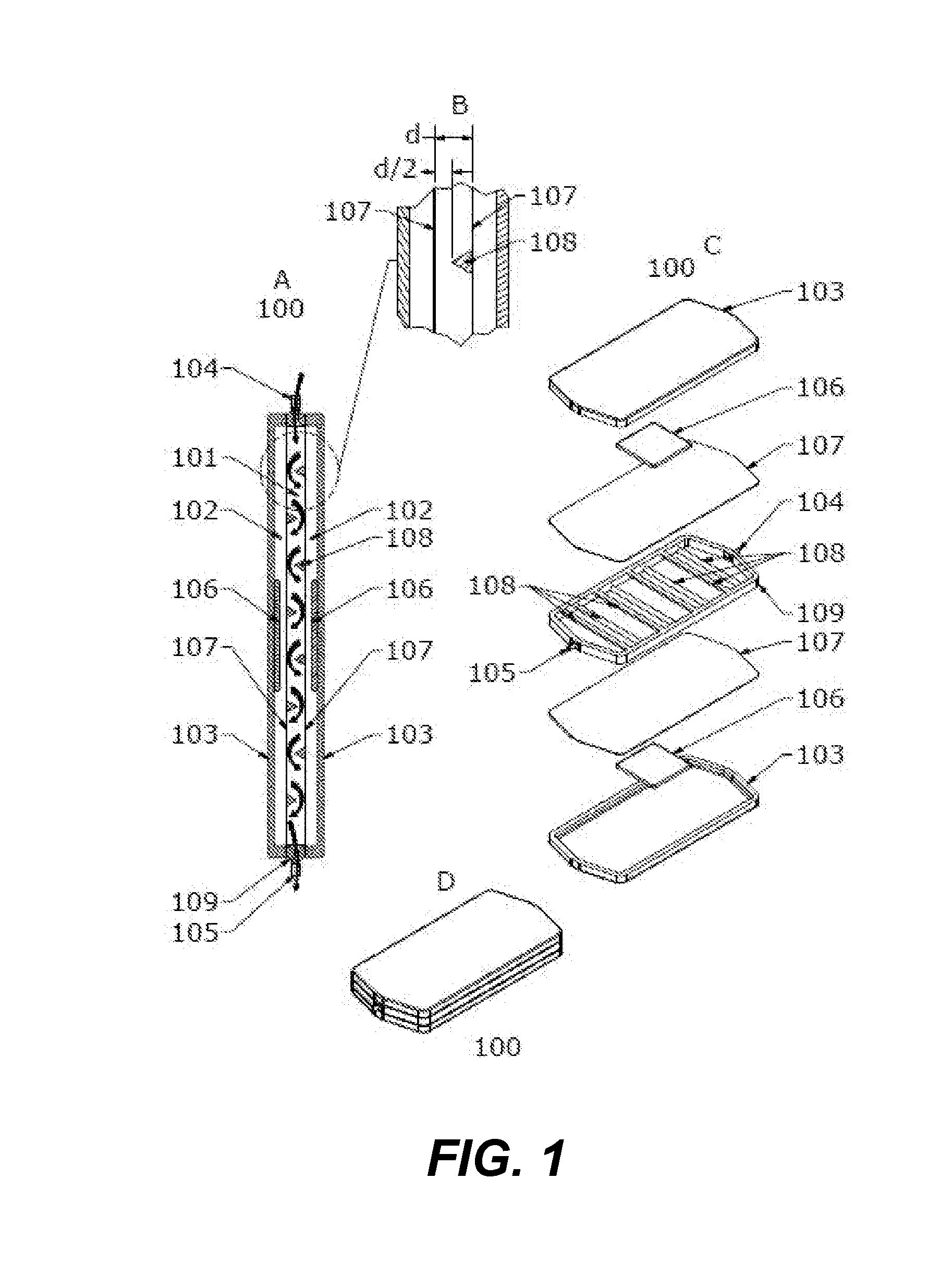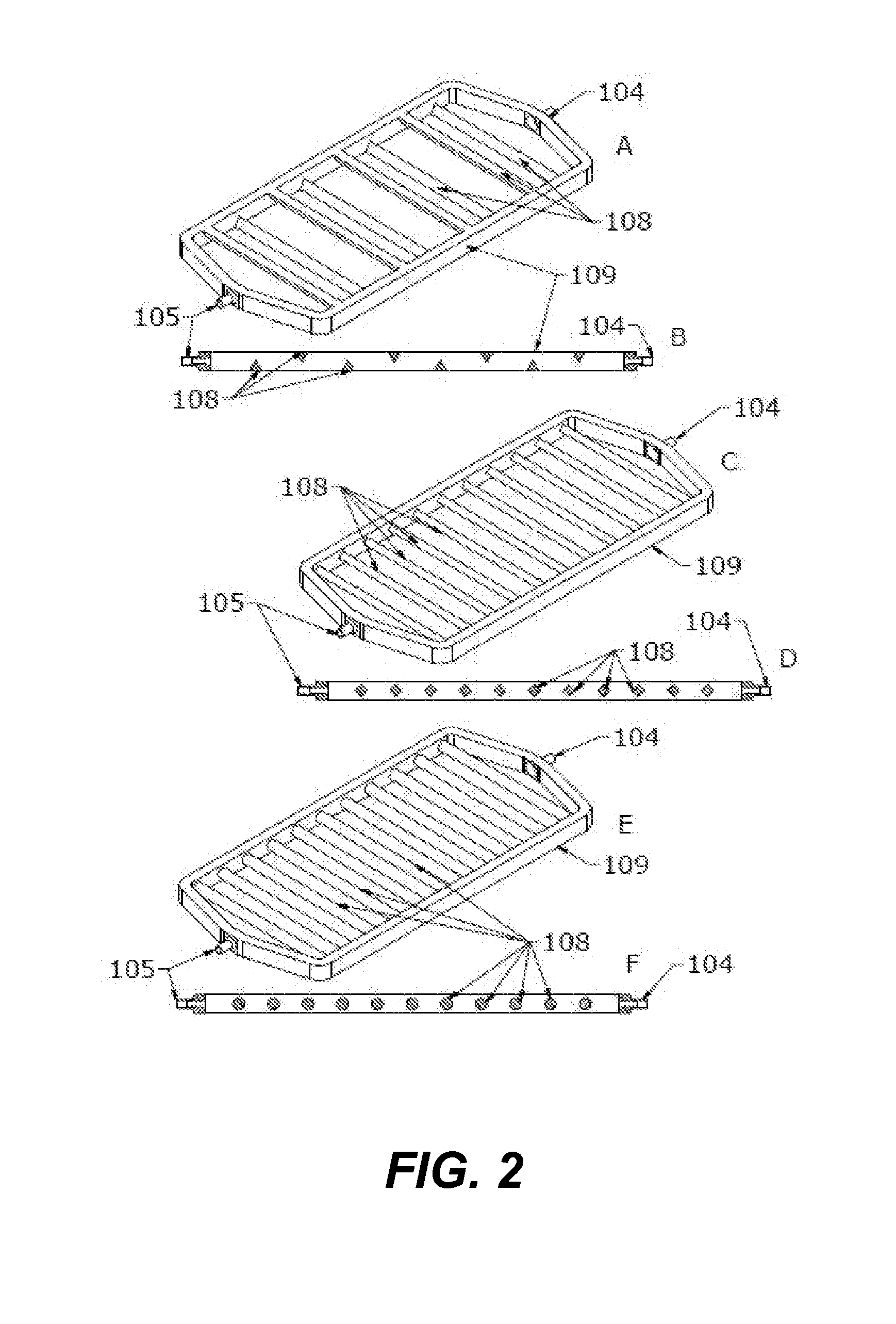Gas depletion and gas addition devices for blood treatment
a technology of gas addition device and blood treatment, which is applied in the direction of liquid degasification by filtration, dead animal preservation, biomass after-treatment, etc., to achieve the effect of reducing the volume of blood products
- Summary
- Abstract
- Description
- Claims
- Application Information
AI Technical Summary
Benefits of technology
Problems solved by technology
Method used
Image
Examples
example 1
Rigid Enclosure, Single Liquid Chamber, Dual Depletion Chamber Device
[0190]FIGS. 1A, 1B and 1C depict a rigid enclosure depletion device 100 with a single liquid chamber 101 and two depletion chambers 102. The two depletion chambers 102 are formed by rigid enclosure outer shells 103 and gas permeable barriers 107. The single liquid chamber 101 is formed by inner shell 109 and gas permeable barriers 107 and has an inlet 104 and an outlet 105. Depletion chambers 102 contain depletion media 106. Gas permeable barriers 107 separate the single liquid chamber 101 and two depletion chambers 102.
[0191]As blood enters the single liquid chamber 101 through the inlet 104, it is exposed to an oxygen depleted environment created by depletion media 106 in depletion chambers 102 where depletion media 106 is a solid O2 and CO2 sorbent combination. This causes the red blood cells to release oxygen and carbon dioxide into the gas depleted environment of depletion chambers 102. The oxygen and carbon d...
example 2
Rigid Enclosure, Dual Liquid Chamber, Three Depletion Chamber Device
[0193]FIGS. 3A, 3B and 3C depict a rigid enclosure depletion device 300 with two liquid chambers 101 and three depletion chambers 102. The two outer depletion chambers 102 are formed by the gas barrier enclosure outer shells 103. The inner depletion chamber 102 is formed by the enclosure shell 110. The two liquid chambers 101 are formed by outer enclosure shells 109 and have inlets 104 and outlets 105. Depletion chambers 102 contain oxygen and carbon dioxide depletion media 106. Gas permeable barriers 107 separate the two liquid chambers 101 and three depletion chambers 102. As liquid enters the liquid chamber 101 through an inlet 104, it is exposed to an oxygen and carbon dioxide depleted environment created by oxygen and carbon dioxide depletion media 106. This causes red blood cells in the liquid to release oxygen and carbon dioxide into the oxygen and carbon dioxide depleted environment. The oxygen and carbon di...
example 3
Flexible Enclosure, Rigid Liquid Chamber, Dual Depletion Chamber Device
[0194]FIGS. 4A-C depict flexible enclosure gas depletion device 400 having a single liquid chamber 101 and having two depletion chambers 102. The two depletion chambers 102 are each formed by gas permeable barrier 107 and flexible shell 129. The single liquid chamber 101 has an inlet 104 and outlet 105 in rigid inner shell 109. Rigid inner shell 109 includes flow control features 108. Depletion chambers 103 contain depletion media 106.
[0195]As liquid containing red blood cells enters the single liquid chamber 101 through the inlet 104, it is exposed to a gas depleted environment created by oxygen and carbon dioxide depletion media 106 through gas permeable barriers 107. This causes the red blood cells to release oxygen and carbon dioxide into the gas depleted environment. Oxygen and carbon dioxide diffuse through the gas permeable barriers 107. The increase in oxygen and carbon dioxide in the depletion chamber ca...
PUM
 Login to View More
Login to View More Abstract
Description
Claims
Application Information
 Login to View More
Login to View More - R&D
- Intellectual Property
- Life Sciences
- Materials
- Tech Scout
- Unparalleled Data Quality
- Higher Quality Content
- 60% Fewer Hallucinations
Browse by: Latest US Patents, China's latest patents, Technical Efficacy Thesaurus, Application Domain, Technology Topic, Popular Technical Reports.
© 2025 PatSnap. All rights reserved.Legal|Privacy policy|Modern Slavery Act Transparency Statement|Sitemap|About US| Contact US: help@patsnap.com



